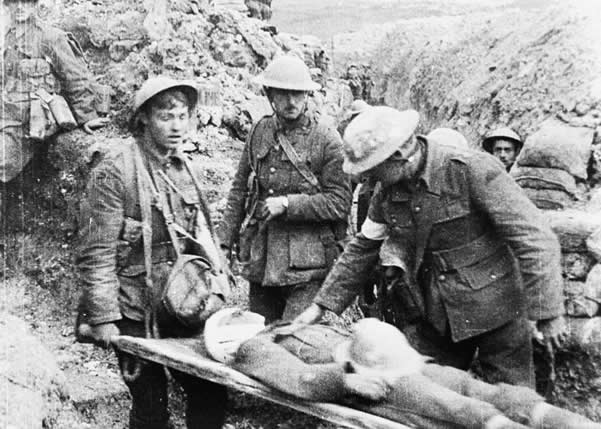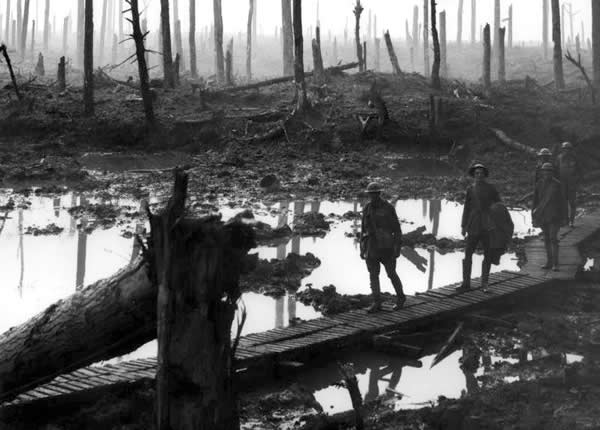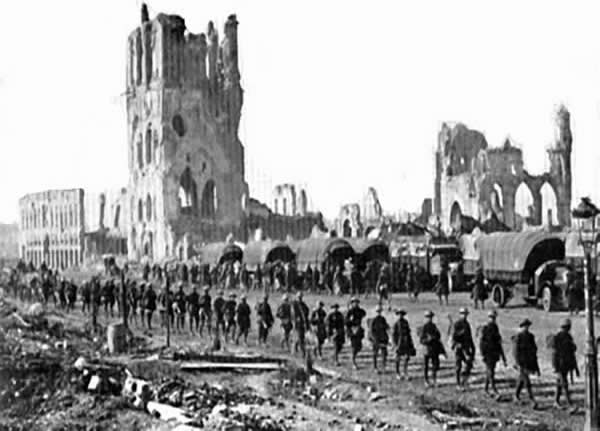The Second Battle of Ypres comprised the only major attack launched by the German forces on the Western Front in 1915, Eric von Falkenhayn preferring to concentrate German efforts against the Russians on the Eastern Front.
Begun in April and used primarily as a means of diverting Allied attention from the Eastern Front, and as a means of testing the use of chlorine gas, it eventually concluded in failure in May. As a consequence of the failure of this attack the German army gave up its attempts to take the town, choosing instead to demolish it through constant bombardment. By the end of the war Ypres had been largely reduced to piles of rubble, the town's magnificent Cloth Hall a wreck (although rebuilt to the original designs in the 1950's).
Second Ypres is generally remembered today as marking the first use of gas on the Western Front. Although introduced with minimal effect on the Russian Eastern Front at Bolimov by the Germans earlier in the war (where it was so cold the gas had frozen), and in conflict with the Hague Convention which outlawed gas warfare, its impact during Second Ypres was startlingly effective.
5,700 canisters containing 168 tons of chlorine gas were released at sunrise on 22 April against French Algerian and territorial division troops following a brief preliminary bombardment by 17-inch howitzers. A veil of greenish-yellow mist could be clearly seen rolling across from the German front lines to the French positions.
Ruins of Ypres as seen from the airThe effectiveness of the gas attack was so complete that it surprised the German infantry who followed up the release of the chlorine gas. The stunned Allied troops fled in panic towards Ypres, the heavy gas settling and clogging the trenches where it gathered. (Click here to read the official German statement issued in the aftermath of the attack.)
Covering four miles of trench lines, the gas affected some 10,000 troops, half of whom died within ten minutes of the gas reaching the front line. Death was caused by asphyxiation. Those who lived were temporarily blinded and stumbled in confusion, coughing heavily. 2,000 of these troops were captured as prisoners of war.
The two advancing Germans corps wearing primitive respirators paced warily through a clear seven kilometre gap in the Allied lines, wary of traps. In planning the attack no reserves had been thought necessary, the German command considering it inconceivable that a major breakthrough could be achieved.
In consequence the actual breakthrough was not exploited to the full. After advancing three kilometres into Allied lines the Germans halted under the hail of a scrambled British General Smith-Dorrien's Second Army counter-offensive. Even so, the loss of high ground to the north significantly weakened the Allied position.
Respiration drill at the frontThe Germans released a second batch of chlorine gas two days later, on 24 April, this time directed against Canadian troops situated north-east of Ypres and again prefaced by a sharp artillery bombardment.
Again the German forces gained ground against the unprotected Canadian troops, although fighting was fierce, spreading far south to Hill 60. The novelty of gas warfare was wearing off, and the advancing German infantry sustained heavy losses from the defending Canadians, who were relieved by arriving British troops on 3 May. During this time the Canadians had suffered heavily, with 5,975 casualties, including 1,000 fatalities.
General Smith-Dorrien proposed a two and a half mile withdrawal closer to Ypres. He felt that nothing short of a large-scale counter-offensive was likely to push the German forces back to their original positions. The idea was met coolly by the Commander-in-Chief of the British Expeditionary Force (BEF), Sir John French, who effectively dismissed Smith-Dorrien by sending him home to England. (Click here to read Sir John French's reaction to the German use of poison gas.)
Ironically Smith-Dorrien's replacement, General Herbert Plumer (later famed for his successful Messines Offensive), also recommended a general withdrawal to French. The suggestion was this time accepted, taking place following a failed Allied counter-attack by two divisions presided over by French General Ferdinand Foch on 29 April. French executed the planned withdrawal on 1-3 May 1915.
General Herbert PlumerFighting renewed around Ypres on 8 May and continued until 13 May, and then again from 24-25 May, with repeated use of gas attacks. Still the Allied lines held, although German forces secured additional high ground to the east of the town from 8-12 May.
On 24 May a heavy German assault forced a further Allied withdrawal, although little extra ground was ceded. A want of supplies and manpower obliged the Germans to call off the offensive; all that they could do was to bombard the town. Even so, the German attacks had considerably reduced the size of the Allied salient. The highest ground had been lost and it was no more than three miles across and five miles deep.
Losses during the Second Battle of Ypres are estimated at 69,000 Allied troops (59,000 British, 10,000 French), against 35,000 German, the difference in numbers explained by the use of chlorine gas. The Germans' innovative use of gas set the trend for the rest of the war.
Although roundly condemned by the Allies as barbaric and reprehensible, sentiments echoed by many neutral nations, the Allies quickly developed their own form of gas warfare, with the British releasing gas canisters at Loos at the end of September 1915 (although the prevailing wind turned and wafted the gas back into the British trenches). All the allied countries had made extensive use of poison gas by the close of the war.
Source firstworldwar.comCommonwealth War Graves
Lest We Forget
From 1914 to1918 97 men and one woman went to War - 20 men never came home. Read the life history of each man and learn where they died
Those Who Gave Their LivesLemsford local History Group WW1 Records
Memories & Letters
Memories from the people of Lemsford Parish – letters from the Front and home and much, much more
Local Parish Magazine
From the Bishop's Hatfield Parish Magazine 1914 to 1918, Church- Social - War Records
Servicemen of Lemsford
War records from 98 men who went to war. We show their memories images and why we should never forget them.
5 Facts the Great War
Battles of WW1

Battle of the Somme
1 July - 13 November 1916The British suffered around 420,000 casualties, the French 195,000 and the Germans around 650,000. Only in the sense of relieving the French at Verdun can the British have claimed any measure of success.

Battle of Passchendaele
31 July - 6 November 1917Passchendaele village lay barely five miles beyond the starting point of his offensive. Having prophesied a decisive success, it had taken over three months, 325,000 Allied and 260,000 German casualties

The First Battle of Ypres, 1914
October 19 to November 22, 1914First Battle of Ypres saw the BEF sustain 7,960 killed, 29,562 wounded, and 17,873 missing, while the French incurred between 50,000 and 85,000 casualties of all types. To the north, the Belgians took 21,562 casualties
